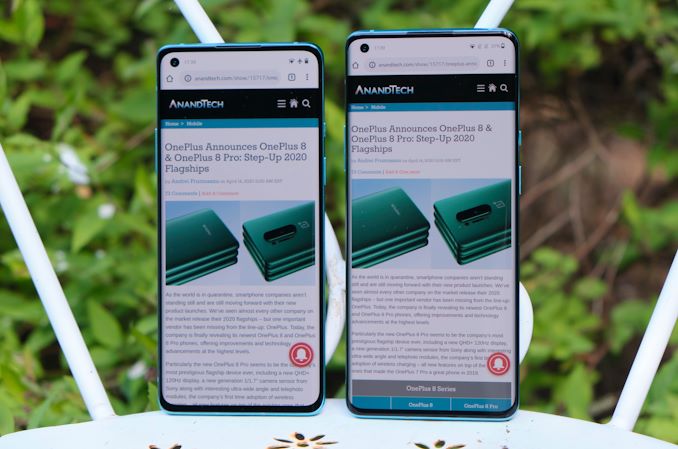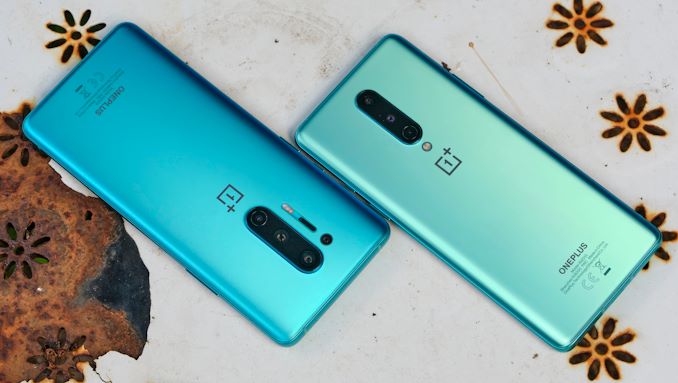The OnePlus 8, OnePlus 8 Pro Review: Becoming The Flagship
by Andrei Frumusanu on June 29, 2020 10:00 AM ESTConclusion & End Remarks
As we’re coming to and end of the review, the biggest question for both the OnePlus 8 and OnePlus 8 Pro is whether they’re devices worth buying.
Design-wise, I really do like what OnePlus has done with both variants. On the OnePlus 8 Pro I’m happy that they dropped the pop-up camera module in favour of a hole-punch front camera setup. Whilst this abandons the seamless full screen experience, the phone is able to gain on internal component spaces that goes to the batteries and cameras and it also gains IP68 certification – all whilst losing weight compared to its predecessor.
I really loved the ergonomics of the smaller OnePlus 8 and this has been easily my favourite form-factor and the best feeling device of the past few years. The symmetrical curves on the front and back glass are a better implementation than the more pronounced display curvature of the OnePlus 8 Pro. We’ve seen other vendors revert on their screen curvature choices and I think OnePlus would also require such a design adjustment in the future.
If you’re opting to get one of the phones – chose one with the matte frosted glass finish. It not only avoids fingerprints a lot better than glossy glass, but it also feels and just looks better. Overall, I think OnePlus did an excellent job on the design of the phones.
The displays of the phones are both fantastic, although obviously the regular OnePlus 8 has lower specifications, going only up to 1080p and 90Hz. The OnePlus 8 Pro’s QHD 120Hz display looks and feels amazing – there’s very little to critique about the phone other than maybe its colour calibration which really wasn’t up to par on my review sample. OnePlus here should spend less on the marketing side and more on the engineering and quality assurance side of things.
Performance of both phones is top-notch, although it’s just in line with other Snapdragon 865 devices. The OnePlus 8 Pro’s 120Hz mode outstanding for scrolling content, and is just second to the S20 series in terms of snappiness. We’ve tested a slew of different new Snapdragon 865 phones recently and they’ve all shared in common excellent GPU sustained performance and thermal characteristics, essentially showcasing no slowdown at all during prolonged usage periods, making the OnePlus 8 and 8 Pro amongst the best Android gaming devices on the market right now.
Battery life was surprising in that the regular OnePlus 8 exceeded our expectations, testing in amongst the longest lasting devices in our mobile suite. The OnePlus 8 Pro’s battery life wasn’t as good – as expected and matching the characteristics of the Galaxy S20 phones, the 120Hz display comes at a great cost to battery life as the software ecosystem just isn’t ready for true variable refresh rate operation.
The OnePlus 8 at 90Hz actually outperformed the OnePlus 8 Pro at 60Hz – and the difference grows to a 32% lead when comparing the two phones in 90Hz vs 120Hz modes. That’s a tough compromise to make given that the smaller phone has a smaller battery – although yes you do get a higher resolution screen and higher refresh rate experience that is indeed noticeable.
On the camera side of things, the regular OnePlus 8 is good – but I wouldn’t quite say it competes quite as well in the flagship segment against the competition. The OnePlus 8 Pro on the other hand easily has a flagship class camera system that not only holds up well with the competition, it even manages to beat them in some aspects such as low-light photography. It’s not a perfect camera system and OnePlus still has to work on their processing, but it’s the best camera experience that the company has ever been able to showcase to date.
In the end, the question of whether the new OnePlus 8 phones are worthy purchases comes down to their prices. Starting with the OnePlus 8 Pro – I think the phone’s starting $/€899 price point the phone easily competes against its closest competitor, that being the S20+. It’s an extremely tough toss-up in almost all aspects of the two phones which is a testament to the fact that the OnePlus 8 Pro is a true flagship device. If you’re in an Exynos market – the OnePlus 8 Pro’s Snapdragon 865 chipset is the obvious choice for better performance and battery life. In the US, the obvious value choice goes to OnePlus again as here we’re still seeing a $300 price gap – with very little compromises in terms of features or quality.
For the OnePlus 8 which starts at $/€699, there’s actually very little competition out there at this price range when what you’re looking for is performance and battery life – as the phone fully delivers and excels on both those aspects. The camera system doesn’t quite match up to an S20 for example, but it also undercuts the S20 by 100€ in Europe. In the US where the S20 is still $999, the differences (QHD screen, 120Hz, wireless charging) between the phones are more easily rationalised by their larger pricing gap.
Overall, I can easily recommend both OnePlus 8 phones – and I don’t think anybody would be disappointed with their purchases. OnePlus was able to produce excellently balanced devices in terms of quality and features as well as their value propositions, and so far, have been a highlight of 2020’s smartphone line-up.












92 Comments
View All Comments
Dexter101 - Monday, June 29, 2020 - link
I feel like the conclusion leaves out some details on pricing. You can compare the MSRP prices and come to conclusions but in 1 month or so the first big deals will start showing up for Samsung flagships with heavy price drops. You'll be able to get an S20+ for less than 700€ then, while the OnePlus phones stay true to their MSRP pricing year round.Considering the quality control issues, the 200€ you save on the Samsung and the generally less buggy software I would likely go for the S20+, although the Snapdragon in all markets is a good advantage in Europe for Oneplus!
Andrei Frumusanu - Monday, June 29, 2020 - link
I compared it at current street prices - the price drops already happened.PeachNCream - Monday, June 29, 2020 - link
In order to be a flagship, generally said thing should be able to float on water and support fly the fleet commander's flag. I suppose Anandtech tested both of those requirements in order to verify the accuracy of the claim as such for the OnePlus 8, but publishing the benchmark data and testing methods used would be good journalism. Also, pics of the command center from which fleet operations are coordinated inside of the OnePlus 8 would be a nice addition to this review given the high importance of tossing about the term "flagship" in even opening the article.eastcoast_pete - Monday, June 29, 2020 - link
Actually, regarding the ability to float: that is a key problem with many (all?) protective cases! What good does IP68 etc. do me if the damn phone (in its protective case) will still sink to the bottom of whatever body of water one is on or close to? I haven't dropped my phone into the sea yet, but friends of mine have while out fishing. So, any protective cases that will let the $ 1,000 smartphone float?Omair - Monday, June 29, 2020 - link
Hi Andrei, The 8 pro actually supports 10W Qi Wireless Charging, not 5W. You can verify it on the Wireless Power Consortium's Website: https://www.wirelesspowerconsortium.com/products/8...Of course, the charger will need to support Qi's Extended Power Profile to get 10W, which most don't (They usually only support 5W Qi, and then Samsung's and Apple's fast charge above that).
But if the charger is advertised as doing 10W on LG, Sony, or Xiaomi phones, it will most likely do 10W on the 8 pro. You can also just check the charger on the WPC's website and see what wattage is listed.
ads295 - Monday, June 29, 2020 - link
I think we're well past the point where meaningful differences in computing hardware made much difference, such as the jump Samsung made with the Exynos 7420 in the GS6, or the jump from eMMC to UFS storage. Even for screen resolution for a 5.5-6" display, you can't get much better than 1440p at 90Hz. At this point companies should focus ONLY on the differentiating features, such as putting in a huge battery (path breaking to have a thicker phone that last long), better camera (no one has perfected this yet), better phone protection (less snowflake), and other tiny lil goodies such as an IR port, heart rate sensor, SpO² sensor that actually are different.ads295 - Monday, June 29, 2020 - link
But it's as if no one has realised this and people are willing to overpay for LaTeSt CPU BrO and MoAr JiGgAbYtEs and establishing phallic measurements.Alistair - Monday, June 29, 2020 - link
They raised the price on the base model from $700-$800 (depending on launch time frame) to $1100 in Canada. Oneplus is dead. Failed company, a huge disappointment. I finally bought an iPhone for the first time, saved a ton of money. How far Android has fallen in the last 5 years in price and quality is sad.alufan - Monday, June 29, 2020 - link
Agree Android is in trouble, Google has let it down badly by allowing all these suppliers to make so much bloat on handsets after starting with the very first Android and now on a S20 Ultra which frankly is rubbish compared to my mate 30pro I had before I think my next phone will be an Apple, I use one for work and whilst its frustrating due to the lack of or ease of customisation options fact is it just works on Android I have 2 calenders, 2 Music players, 2 browsers, I could go on I want to uninstall the Samsung browser and bixby etc etc but I cant, its my goddam device i want them off but you cant and if I root it then my bank apps no longer work...great way to keep customers GoogleAlistair - Tuesday, June 30, 2020 - link
What is especially worrying is the price bloat. Snapdragon and various Android phone part suppliers seem to be upping their prices dramatically. A Snapdragon 865 should be a lot cheaper and we're hearing rumors they want to charge even more for next year.